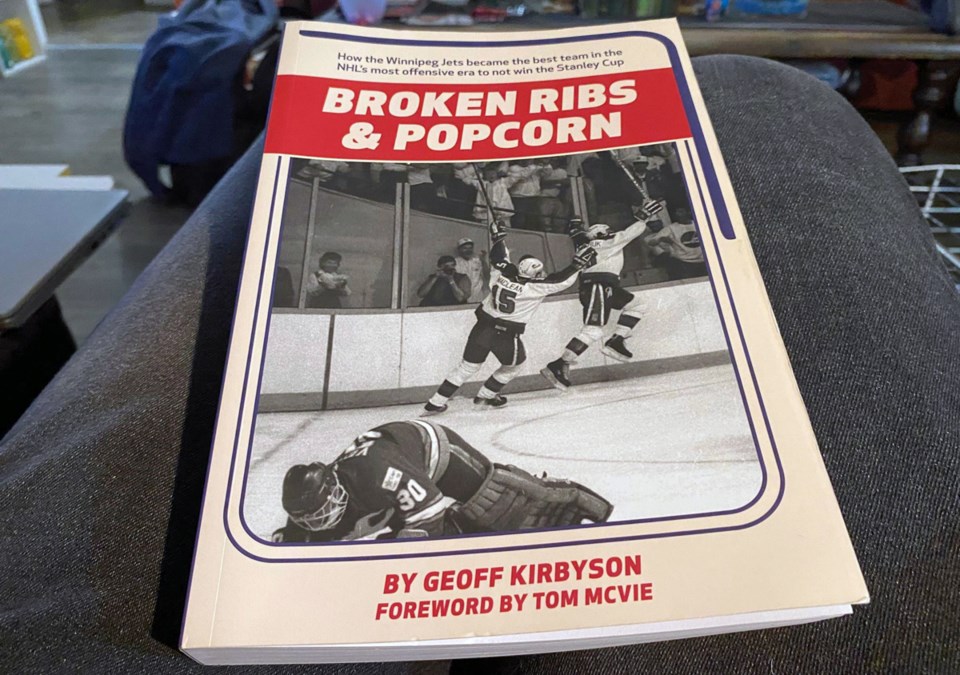YORKTON - When I was a youngster my dad was a Montreal Canadiens fan, so I had to cheer for Toronto the only other Canadian team at the time – yes I am that old.
Then when Vancouver joined the NHL, I split allegiances.
When Winnipeg was allowed into the NHL they became the closest team and so were added to my favourites’ list.
So as a Jet fan I was more than pleased to get a review copy of Broken Ribs and Popcorn: How the Winnipeg Jets Became the Best Team in the NHL's Most Offensive Era to Not Win the Stanley Cup by Geoff Kirbyson.
I’ll state right here that if you are a Jets fan, then this book should be on your list of ‘must-reads’.
The book is a hugely entertaining 440-plus pages covering the Jets briefly from their last AVCO Cup winning season in the World Hockey Association until their ridiculous move to Phoenix forced there as part of Gary Bettman’s skewed American NHL dream, and a lack of foresight with Manitoba at the time.
Kirbyson said he sort of grew up through the period covered by the book.
“I was 11-years-old when the Jets made the jump to the NHL,” he said.
The first run of the Jets in Winnipeg was one where the team went from awful, gutted by a vindictive NHL punishing its four WHA additions, to a team that seemed on the cusp of Stanley Cup glory – except there was the Edmonton Oilers also in the path.
For a book literally about the Jets, there is considerable attention paid to the nasty Oilers and to a lesser extent the Calgary Flames as the three teams were in a near constant struggle for Smythe Conference supremacy for years – the Oilers generally coming out on top.
“The Smythe Division was the toughest division in hockey,” offered Kirbyson.
It is that intertwined relationship with the Flames and Oilers which author Kirbyson said broadens the appeal of the book if they just give it a chance.
For those not around back then, when the Jets merged with the NHL in the spring of 1979, they lost most of the players who led them to the team’s third AVCO Cup victory that spring — Kent Nilsson, Terry Ruskowski, Rich Preston, Kim Clackson and Barry Long.
They were only able to protect two skaters — Morris Lukowich and Scott Campbell — and a single goalie, Markus Mattsson.
But, general manager John Ferguson proved a savvy team builder, using, as the publisher page noted “a patchwork of players for the first couple of years but after drafting Dave Babych No. 2 overall in 1980 and Dale Hawerchuk first overall the year after, he had the core around which he would build his team for the rest of the decade.”
While the NHL gutted the Jets and their sister WHA teams in Hartford, Quebec City and Edmonton as a sort on penance for their audacity to take in the NHL by –°¿∂ ”∆µ part of the rival WHA, the three Canadian teams would eventually roll out of the doldrums to have some really fine teams.
The issue for the Jets was that the Oilers would develop a truly great team led by Wayne Gretzky, Mark Messier, Paul Coffey, Jari Kurri and Glen Anderson.
As great at the quintet was, as Kirbyson interviewed for his book, it was another Oiler which Jet players consistently pointed to as the reason they did not fare better against the Oilers – goaltender Grant Fuhr.
“Grant Fuhr was the guy that didn’t give up the crucial goal,” offered Kirbyson in a recent interview with Yorkton This Week, adding that might mean a 2-1 or a 7-6 win, but Fuhr had a knack of the save when it mattered most.
And, so it was that the Oilers constantly blocked the Jets. In fact in each of the Oiler Stanley Cup seasons they defeated the Jets on the playoff road, noted Kirbyson.
“It’s (the book) is also kind of a hockey tragedy,” said Kirbyson.
While it’s true there are bad memories rekindled for Jet fans, the insight of players Kirbyson includes here is too compelling to ignore. Jet fans do check it out.






